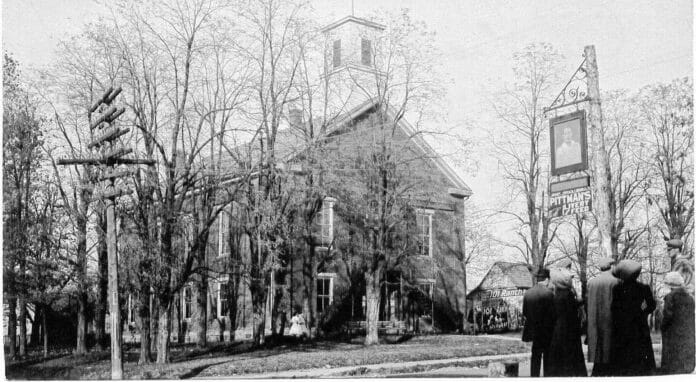In the early life of Brown County, 1836, the justices of the peace played a part in the government of the county. They met as the county commissioners now meet to transact business. We know, from the Weston Goodspeed history, that the meetings of this county board were held at the home of James Dawson.
As the families grew larger and more people moved into Brown County, the need for a courthouse grew.
On June 1, 1837, a contract was awarded to David Weddle to build a two-story courthouse of hand-hewn logs, 18 feet wide and 24 feet long in true rectangular design. The building would be heated by two fireplaces.
The courthouse served the needs of county government for 16 years before the building needed to be replaced. The building was dismantled, and the logs were sold in 1858. For a year or more, the courts were held in the Methodist church.
In 1853, a contract to build a brick courthouse was let to John Douglas. It was finished by 1855, at a total cost of $7,000. This fine building was planned to serve the need of county government for many years.
Tuesday morning, Nov. 4, 1873, found the commissioners with sad faces. The courthouse was burning. Not all, but many records were destroyed. The adjoining towns, Columbus and Bloomington, had headlines in their newspapers announcing the burning of the Nashville Courthouse.
In the afternoon of Nov. 4, 1873, the auditor, William Watson and two commissioners, Robert Henderson and Allen Anderson, also Sheriff Alfred Sipes, met at Browning and Prather’s law office to transact business concerning the burning of the courthouse.
The next day, Nov. 5, when the three commissioners, John Stillenbauer, Allen Anderson and Robert Henderson, met with the auditor and sheriff in a special session, John Genolin offered a room on the first floor of a brick building on the east end of lots 50, 51 and 52 (now the Nashville House), also the north room of a building on lot 4 (where the present post office is), and a frame house of four rooms on the north side of the Nashville and Columbus highway, adjoining the plat of Nashville, for the transaction of business. Rent was $220 per annum.
John Genolin also allowed the use of a hall over his store on lot 5 in Nashville, for a jury room during sessions of a circuit at $1 per day for each day the court met.
Many were willing to surmise how the fire started. Some said an angry citizen did the job. Others said it was set to cover up embezzlement of county funds.
In the year 1874, a contract was let for a new brick courthouse for Brown County, at a cost of $9,000: $4,500 to be paid when the building was under roof, and $4,500 paid two years after completion with 10 percent interest. This building was finished by 1877 and is our present courthouse. It was built on the foundation of the first brick courthouse.
It, too, is rectangular in design and two stories high. The front entrance is in the south end. The second story is reached from outside by two wrought-iron stairways over the lower floor entrance with a platform between them.
In 1930, water was piped from the creek to flush the outside toilets and to fill the pipes of the heating system and the hot-water radiators. The water was heated by coal burning furnaces. Water came to Nashville in 1948. This, the third courthouse, is heated by stoves. The courthouse acquired electric lights when the town bought a large light plant in the 1920s. In 1962, Warford Construction and Supply Company revamped the wiring and hung new light fixtures. They also replaced the old coal-burning furnaces with an oil-burning furnace. Much repair and remodeling was needed. By 1964, this remodeling was complete.
In 1939, the commissioners, Fred Thickston, L. B. Zody and Bennie Petro, awarded a contract to Foss, Luke and Taylor with McGuire and Shook as architects, to build on the north end of the courthouse a one-story-high extension long enough to provide room for health facilities.
In recent years, Lee Waltman added a second story to that extension which gave the courthouse more spaces for added rooms for activities of the judge of the court.
The courthouse lawn had a well, a pump and a common drinking cup for all to use.
This story is shared with you from “Brown County Remembers.”
— Submitted by Pauline Hoover, Brown County Historical Society





